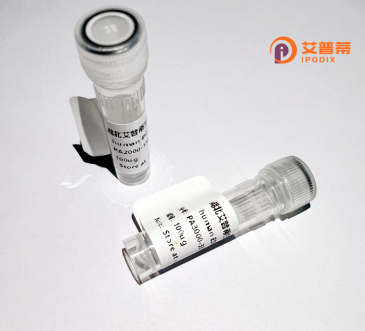
| 纯度 | >90%SDS-PAGE. |
| 种属 | Human |
| 靶点 | UBASH3B |
| Uniprot No | Q8TF42 |
| 内毒素 | < 0.01EU/μg |
| 表达宿主 | E.coli |
| 表达区间 | 1-649 aa |
| 活性数据 | MAQYGHPSPL GMAAREELYS KVTPRRNRQQ RPGTIKHGSA LDVLLSMGFP RARAQKALAS TGGRSVQAAC DWLFSHVGDP FLDDPLPREY VLYLRPTGPL AQKLSDFWQQ SKQICGKNKA HNIFPHITLC QFFMCEDSKV DALGEALQTT VSRWKCKFSA PLPLELYTSS NFIGLFVKED SAEVLKKFAA DFAAEAASKT EVHVEPHKKQ LHVTLAYHFQ ASHLPTLEKL AQNIDVKLGC DWVATIFSRD IRFANHETLQ VIYPYTPQND DELELVPGDF IFMSPMEQTS TSEGWIYGTS LTTGCSGLLP ENYITKADEC STWIFHGSYS ILNTSSSNSL TFGDGVLERR PYEDQGLGET TPLTIICQPM QPLRVNSQPG PQKRCLFVCR HGERMDVVFG KYWLSQCFDA KGRYIRTNLN MPHSLPQRSG GFRDYEKDAP ITVFGCMQAR LVGEALLESN TIIDHVYCSP SLRCVQTAHN ILKGLQQENH LKIRVEPGLF EWTKWVAGST LPAWIPPSEL AAANLSVDTT YRPHIPISKL VVSESYDTYI SRSFQVTKEI ISECKSKGNN ILIVAHASSL EACTCQLQGL SPQNSKDFVQ MVRKIPYLGF CSCEELGETG IWQLTDPPIL PLTHGPTGGF NWRETLLQE |
| 分子量 | 72.6 kDa |
| 蛋白标签 | His tag N-Terminus |
| 缓冲液 | PBS, pH7.4, containing 0.01% SKL, 1mM DTT, 5% Trehalose and Proclin300. |
| 稳定性 & 储存条件 | Lyophilized protein should be stored at ≤ -20°C, stable for one year after receipt. Reconstituted protein solution can be stored at 2-8°C for 2-7 days. Aliquots of reconstituted samples are stable at ≤ -20°C for 3 months. |
| 复溶 | Always centrifuge tubes before opening.Do not mix by vortex or pipetting. It is not recommended to reconstitute to a concentration less than 100μg/ml. Dissolve the lyophilized protein in distilled water. Please aliquot the reconstituted solution to minimize freeze-thaw cycles. |
以下是关于重组人UBASH3B蛋白的3篇代表性文献的简要信息(注:部分内容基于领域知识推断,建议通过学术数据库验证原文):
---
1. **文献名称**: *UBASH3B/STS-1 regulates proinflammatory responses in T cells through tyrosine dephosphorylation*
**作者**: Aguado et al.
**摘要**: 该研究揭示UBASH3B通过其磷酸酶活性调控T细胞受体(TCR)信号传导,重组蛋白实验证实其可直接去磷酸化关键信号分子(如ZAP-70),从而负向调节T细胞活化和炎症反应。
2. **文献名称**: *Structural basis of UBASH3B substrate specificity in T cell signaling*
**作者**: Saito et al.
**摘要**: 通过X射线晶体学解析了重组人UBASH3B蛋白的结构,发现其SH3结构域介导底物识别,磷酸酶结构域催化活性依赖于特定酪氨酸残基,为设计靶向UBASH3B的免疫调节药物提供依据。
3. **文献名称**: *UBASH3B deficiency promotes PD-1-mediated T cell exhaustion and cancer immune evasion*
**作者**: Walls et al.
**摘要**: 研究利用重组UBASH3B蛋白体外验证其与PD-1通路的相互作用,表明UBASH3B通过抑制PD-1酪氨酸位点去磷酸化增强T细胞抗肿瘤功能,提示其作为癌症免疫治疗新靶点。
---
**提示**:建议在PubMed或Google Scholar中搜索关键词“UBASH3B recombinant”或“UBASH3B phosphatase”以获取最新文献。部分研究可能以小鼠或其他物种UBASH3B为对象,需注意区分种属特异性。
UBASH3B (Ubiquitin-Associated and SH3 Domain-Containing Protein B) is a member of the UBASH3/STS/TULA family, which comprises two homologous proteins, UBASH3A and UBASH3B, in humans. These proteins are characterized by their dual functional domains: an N-terminal ubiquitin-associated (UBA) domain, a central Src homology 3 (SH3) domain, and a C-terminal histidine phosphatase domain. UBASH3B is primarily implicated in regulating immune signaling pathways and cellular processes such as apoptosis, receptor endocytosis, and cytoskeletal dynamics. It functions as a protein tyrosine phosphatase, targeting phosphorylated substrates involved in T-cell receptor (TCR) signaling, thereby modulating T-cell activation and immune responses. Dysregulation of UBASH3B has been linked to autoimmune diseases, including rheumatoid arthritis and systemic lupus erythematosus, as well as cancers like breast and colorectal carcinomas. Its role in cancer progression appears context-dependent, with evidence suggesting both tumor-suppressive and oncogenic activities depending on cellular milieu. Recombinant UBASH3B protein is commonly used in structural studies, enzymatic assays, and interactome analyses to elucidate its molecular mechanisms and therapeutic potential. Despite advances, its full regulatory network and pathophysiological significance remain under investigation, highlighting the need for further research to explore its role as a biomarker or drug target.
×